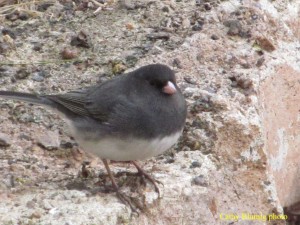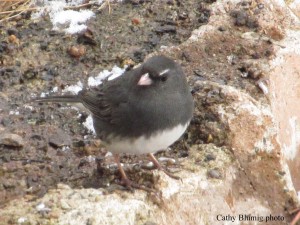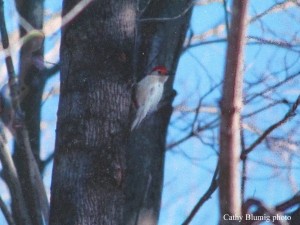Over 180 species of birds have been observed from the grounds here at Wolgast Tree Farm and while it’s always exciting to see a species we haven’t seen on the farm before, we still enjoy observing the “regulars.” One of the “regulars” during the winter months are Dark-eyed Juncos (Junco hyemalis).

A dark-eyed junco belonging to the slate-colored race which is commonly seen on our tree farm during the winter months.
Dark-eyed juncos like to hang out on the ground around the brush piles and thickets we maintain on the farm. They are also frequent visitors to our bird feeders (fortified with an old Christmas tree nearby to help provide the cover that they like). Most of the juncos we observe belong to a race known as slate-colored, but for the last two weeks we’ve been watching a bird that looks like the Oregon race of the Dark-eyed Junco, a race commonly seen in the Pacific Northwest.
We’ve seen the Oregon race on the farm before (for one day last winter), but this bird has been an almost daily visitor to our bird feeders and is a real standout as it forages among the more numerous relatives.
Sometimes we’ll see birds that have patches of white feathers on their body that would normally be a different color. Since these birds still have some colored feathers they are said to be leucistic rather than albino (a true albino bird would have all white feathers and have red eyes). Birds with feathers that are abnormally white are thought to have a genetic defect that prevents melanin from being properly deposited in those feathers. Sometimes when birds exhibit these white feathers it can be pretty discreet. For example, below is a dark-eyed junco that has a white “eyebrow” over its left eye that photographed last week.

A dark-eyed junco with a white "eyebrow" over its left eye caused by white feathers. The feathers are white most likely because the bird has a genetic defect that prevented melanin from being properly deposited in the feathers.
We photographed a bird last winter with the same marking which makes us think it could be the same bird but we don’t know for sure. The majority of song birds hatched during a given season don’t live beyond a year, but some do and perhaps this bird is an example of that. We’ll probably never know for sure. Picking out birds with unique plumage, especially when it’s so subtle is one of the many pleasures of bird watching.
A more obvious example of leucism that we observed on the farm a few years ago involved a red-bellied woodpecker. We think red-bellied woodpeckers are already striking birds, but seeing one that was almost all white really caught our eye.

This photo is lousy, but this leucistic red-bellied woodpecker was a cool-to-see visitor to our farm during the winter of 2010-2011.
We first saw the bird (a male) on Thanksgiving morning in 2010 and observed it every day up to March 25, 2011. Then it was gone and we haven’t seen such a bird since. If you look at the photo very closely you can see the red belly feathers that give this species its name just below where the feet are clinging to the tree.
Early on we figured he would get picked off by a Cooper’s hawk or another bird of prey since he should have been easy to pick out, but surprisingly we actually saw red-bellieds with normal plumage get taken first. Predation is part of the natural cycle of life, but we’d be lying if we told you we weren’t “rooting” for this bird to make it. In fact, keeping tabs on this bird probably accelerated our own “leucistic transformation” (gray hairs) as we sometimes fretted over its fate. Whether it ultimately got killed by a hawk or something else, or just moved on, we don’t know, but we certainly enjoyed watching him while he was here and we consider it one of the highlights of birds that have visited Wolgast Tree Farm.
